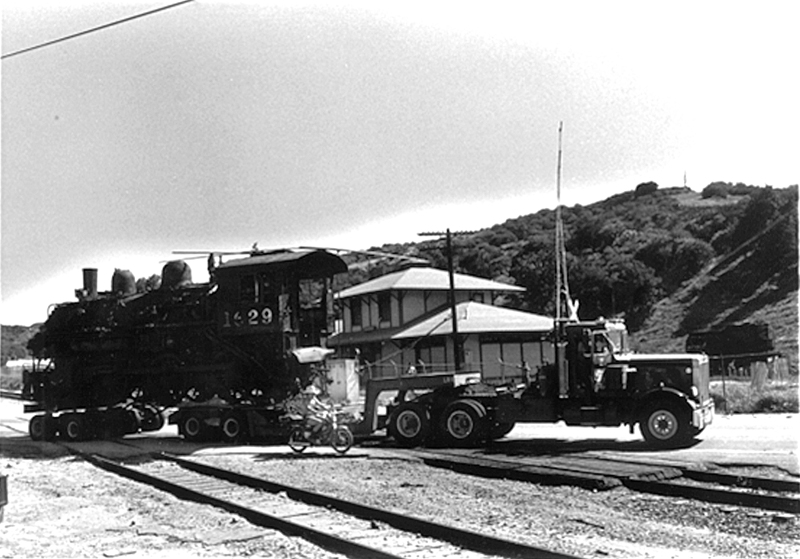|
|
Heritage Junction Historic Park, Newhall

April 22, 1982 — Gene Autry's Mogul Locomotive No. 1629 moves into Heritage Junction Historic Park in Newhall. Photo by Tony Mason / SCV Historical Society collection.
About Engine No. 1629. Southern Pacific Mogul Engine No. 1629 is a class M4 steam locomotive (initially class ED) weighing 75 tons — "mogul" being the name for locomotives with a 2-6-0 wheel configuration (two leading wheels on one axle, six powered and coupled driving wheels on three axles, no trailing wheels). The engine was built in November 1900 by Schenectady Locomotive Works of New York and placed into service by the Southern Pacific Railroad on December 6, 1900, for light freight service on the line that ran from Yuma, Ariz., to Portland, Ore., passing through the Santa Clarita Valley. No. 1629 was one of 75 moguls that the Southern Pacific received from Schenectady and from Cooke of New Jersey during 1900 and 1901. In the latter year the two manufacturers merged with seven others to form American Locomotive Company (ALCO). The SP wasn't ordering locomotives from the big dog, Baldwin, at the time, because of a dispute between SP President Collis P. Huntington and Baldwin that dated back to the construction of the Central Pacific Railroad in the 1860s. The SP changed its policy and started ordering most of its locomotives from Baldwin following Huntington's death in August 1900. Apparently the order was already placed or the policy hadn't yet changed by the time our locomotive was ordered from Schenectady, where it was given a sequential manufacturing number of 5680. It's uncertain whether Schnectady rigged No. 1629 to burn coal or oil for fuel. Between 1905 and 1910, the Southern Pacific would convert its entire fleet to oil burners (Hungerford 1959:9); it's possible No. 1629 was oil-fired from birth. Initially, the engine number ("1629") would have appeared on the tender and the railroad's name in Roman lettering on the cab. Beginning in 1916, the scheme was changed to the number on the cab and "SOUTHERN PACIFIC LINES" on the tender. After 1946, the lettering was abbreviated to "SOUTHERN PACIFIC," and the front of the boiler (or "nose") and the smokebox were changed from all-black to (metallic gray) graphite linseed oil paint. In all cases, it took a couple of years for the changes to be implemented fleet-wide. Records indicate No. 1629 was either retrofitted or overhauled August 25, 1928, at the SPs' Sacramento shops. After World War II, when the Southern Pacific and other lines were scrambling to renew their fleets after a wartime halt to regular locomotive production, No. 1629 was leased for two short months to the Southern Pacific of Mexico (Sud-Pacífico de México) — March 16, 1946, to May 10, 1946. Although a subsidiary of the Southern Pacific, SPdeM had a separate corporate structure because Mexico required railroad companies to be domiciled in Mexico. (The same was true of another SP subsidiary, Texas & New Orleans, because Texas had the same requirement.) No. 1629 officially retired from service at Tucson on May 1, 1957 — the year the steam era ended on the Southern Pacific, fully replaced by diesel. Western actor Gene Autry purchased the old workhorse and added it to his new and growing collection of locomotives at his Melody Ranch studio in Placerita Canyon. Engine No. 1629 was his fifth such acquisition; it was delivered June 17, 1957 (The Signal, June 20, 1957). It reportedly appeared in Melody Ranch-based television series such as "Gunsmoke" and "The Life and Legend of Wyatt Earp." No. 1629 was no stranger to the camera. According to the Arizona Daily Star, its film career actually started while still in active service in the SP's Tucson division, having appeared in some 20 movies made in Southern Arizona before 1957. According to The Signal, in the late 1950s Autry was planning to open Melody Ranch to the public and was preparing to lay track for a narrow-gauge train that would take tourists on rides around the ranch. It was part of his plan to open a Western museum on the property. The 1962 fire snuffed out that idea — but luckily, it didn't completely kill it. Autry would see his dream come true at Griffith Park in 1988. By that time, Autry had donated Engine No. 1629 to the Santa Clarita Valley Historical Society. Offered in 1981, it was moved with donated funds April 22, 1982, to its present location next to the Saugus Depot where it has been restored as a static display. Principal source for manufacturing information: Diebert & Strapac 1987.
HS8201: 9600 dpi jpeg. |
The site owner makes no assertions as to ownership of any original copyrights to digitized images. However, these images are intended for Personal or Research use only. Any other kind of use, including but not limited to commercial or scholarly publication in any medium or format, public exhibition, or use online or in a web site, may be subject to additional restrictions including but not limited to the copyrights held by parties other than the site owner. USERS ARE SOLELY RESPONSIBLE for determining the existence of such rights and for obtaining any permissions and/or paying associated fees necessary for the proposed use.






